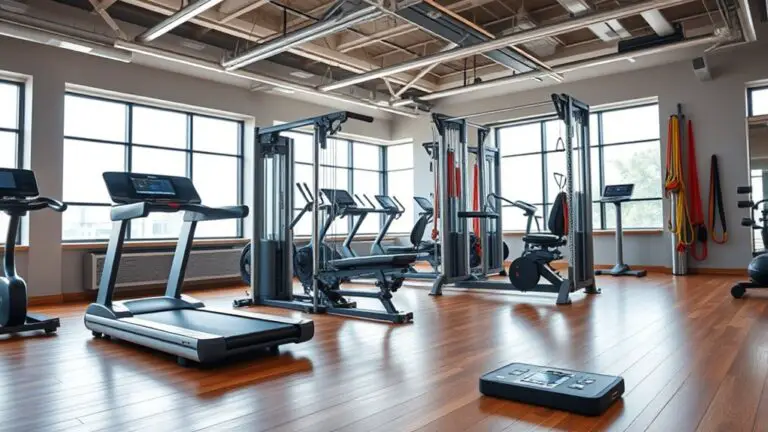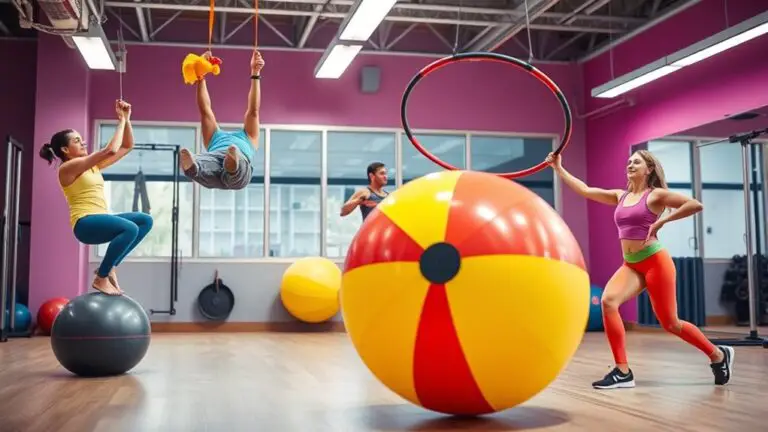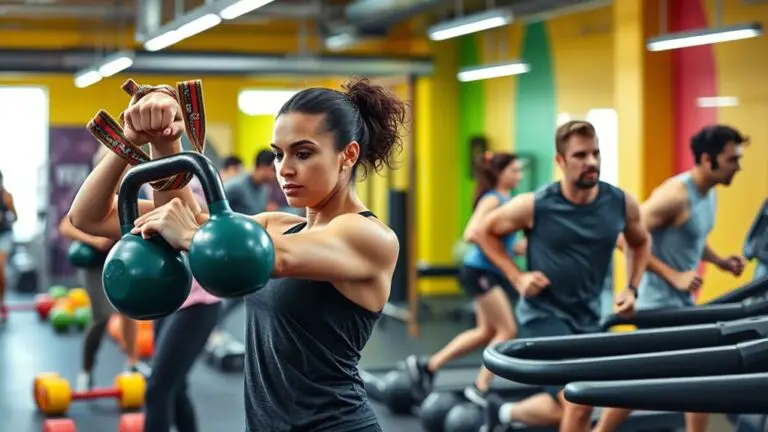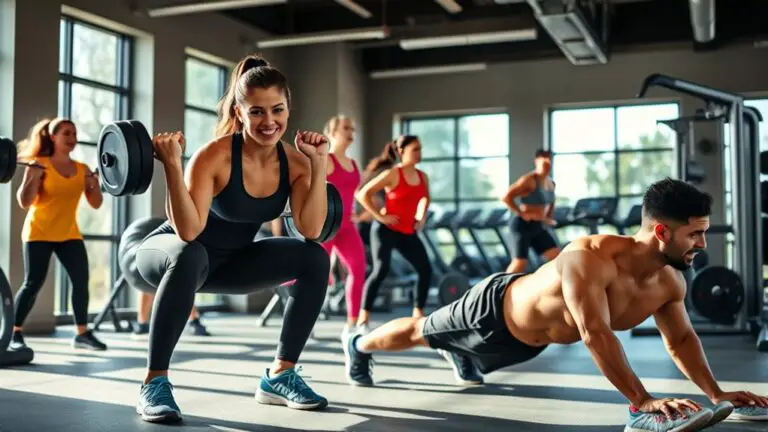How to Pick the Right Lifting Belt for Gym Workouts

To pick the right lifting belt for your gym workouts, consider its importance for core stability and injury prevention. Choose a material that fits your needs—leather for durability, or nylon for flexibility. Select the appropriate width for your lifting style, and explore buckle types like prong or lever for secure adjustments. Guarantee you find the perfect size for comfort and support. There’s much more to learn about maintaining and choosing the best options for you.
Understanding the Importance of a Lifting Belt
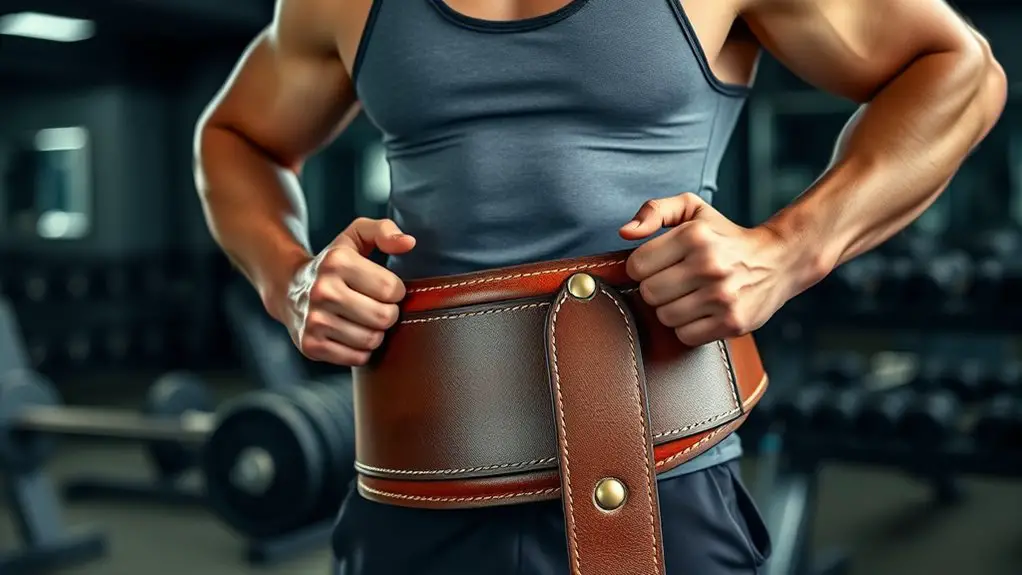
When you’re lifting heavy weights, a lifting belt can make a significant difference in your performance and safety. Wearing a belt helps stabilize your core, providing the support you need to maintain proper form during intense lifts. This added stability translates to better lifting mechanics, which is essential for maximizing your strength and minimizing the risk of injury.
One of the key lifting belt benefits is injury prevention. By reinforcing your lower back and abdomen, a belt reduces the strain on these areas, helping to protect against common injuries like strains or herniated discs. It also encourages you to engage your core muscles more effectively, promoting safer lifting habits. Ultimately, incorporating a lifting belt into your routine can enhance your performance while prioritizing your safety, allowing you to focus on reaching your fitness goals without the worry of getting hurt.
Choosing the Right Material for Your Belt
When it comes to choosing the right material for your lifting belt, you’ll want to evaluate the options available, like leather and synthetic materials. Each has its own thickness, durability, breathability, and comfort level, which can impact your performance. Understanding these factors will help you make an informed decision that suits your workout needs.
Leather vs. Synthetic Options
Have you ever wondered whether leather or synthetic materials make for a better lifting belt? Both options have their benefits, and understanding them can help you choose the right one for your workouts.
- Leather Durability: Leather belts are known for their long-lasting strength, providing excellent support during heavy lifts.
- Synthetic Flexibility: Synthetic belts often offer greater flexibility, allowing for easier movement as you perform different exercises.
- Comfort and Fit: Consider how each material feels against your skin. Leather may require breaking in, while synthetic options often feel more comfortable right away.
Ultimately, your choice should align with your lifting style and safety needs. Prioritize what feels best for your body to guarantee effective and safe workouts.
Thickness and Durability Factors
Choosing the right thickness for your lifting belt is vital for maximizing both support and comfort. A thicker belt typically offers greater stability, which can help you maintain proper form during lifts. However, it’s important to balance thickness with flexibility. Look for belts made using quality belt construction techniques that guarantee durability while adhering to weightlifting safety standards. A well-constructed belt will withstand heavy use without compromising your safety. Generally, a thickness of 10mm to 13mm is recommended for serious lifters, as it provides ample support without being overly rigid. By selecting a belt that meets these criteria, you’ll enhance your lifting experience and reduce the risk of injury. Remember, safety should always come first in your workouts.
Breathability and Comfort Level
While a sturdy lifting belt is crucial for support, the material it’s made from plays an important role in breathability and comfort. When choosing a lifting belt, consider these factors to guarantee you stay safe and comfortable during your workouts:
- Breathable Fabrics: Look for materials that allow air circulation, reducing moisture buildup and keeping you cool.
- Comfort Padding: Choose a belt with adequate padding to prevent discomfort during heavy lifts, allowing for better focus on your form.
- Adjustability: Select a belt that can be easily adjusted to fit snugly without compromising your mobility.
Selecting the Appropriate Width
When it comes to selecting the appropriate width for a lifting belt, comfort and support are key factors to contemplate. The width affects lifting belt functionality and should match your workout intensity and lifting style. A wider belt provides better support for heavy lifts but may feel restrictive during lighter workouts.
| Width (Inches) | Best For |
|---|---|
| 4 | Heavy lifting and powerlifting |
| 3 | General strength training |
| 2 | Lighter workouts and mobility |
Choosing the right width guarantees you’re protected during your lifts while allowing enough freedom for movement. Remember, a properly fitted belt enhances stability and core support, reducing the risk of injury. So, assess your training goals and select a width that balances support with comfort. You’ll find that the right choice makes a real difference in your performance and safety in the gym.
Exploring Different Buckle Types

What type of buckle do you need for your lifting belt? Choosing the right buckle type is vital for both safety and performance. Different buckle styles offer various benefits, so it’s important to understand what suits your needs best. Here are three common buckle types you might consider:
Choosing the right buckle for your lifting belt is crucial for safety and performance. Understand the options to find your perfect fit.
- Prong Buckle: This classic design features a metal prong that slides into the belt holes, providing a secure fit. It’s reliable and easy to adjust.
- Lever Buckle: This style allows for quick adjustments by lifting a lever, making it convenient for switching between different exercises. It offers a snug fit, enhancing stability.
- Velcro Buckle: Ideal for beginners, this buckle type uses a Velcro strap for easy closure. While it’s not as tight as others, it offers comfort and ease of use.
Finding the Perfect Size for Comfort and Support
When it comes to finding the right lifting belt, you’ll want to start by accurately measuring your waist size for the best fit. The width of the belt and the material it’s made from also play essential roles in providing comfort and support during your workouts. Let’s break down these factors to guarantee you choose a belt that enhances your lifting experience.
Measuring Your Waist Size
How can you guarantee your lifting belt fits perfectly? Start by accurately measuring your waist size using reliable waist measurement techniques. A proper fit is vital for both comfort and support during your workouts. Here are three essential steps to make certain you get the right size:
- Use a flexible measuring tape: Wrap it around your waist, just above your hip bones, making sure it’s snug but not tight.
- Take the measurement: Record the number where the tape overlaps, as this will be your waist measurement.
- Refer to fitting guidelines: Check the manufacturer’s sizing chart to find your corresponding belt size.
Following these proper fitting guidelines will help you select a lifting belt that offers the safety and support you need while lifting.
Selecting Belt Width
Choosing the right width for your lifting belt is essential, as it directly impacts both comfort and support during your workouts. A wider belt often provides better support for your lower back, helping you maintain proper form and preventing injuries. However, it’s vital to find a width that doesn’t restrict your movement or breathing. Typically, belts range from 3 to 4 inches in width; 4-inch belts are great for heavy lifting, while 3-inch belts may suit those looking for more flexibility. Remember, the right fit can enhance belt performance and improve your workout efficiency. Always try on different widths to find the balance between support and comfort that works best for your lifting routine.
Choosing Material Type
The material of your lifting belt plays an essential role in both comfort and support during workouts. Choosing the right material affects belt functionality and material durability, guaranteeing your safety while lifting. Here are three key considerations when selecting a belt:
- Leather: Offers excellent durability and support, ideal for heavy lifting, but may take time to break in.
- Nylon: Lightweight and flexible, providing comfort during dynamic movements, but may not offer the same level of support as leather.
- Neoprene: Known for its cushioning effect, it’s great for beginners, but make sure it has adequate support for your lifting needs.
Selecting the right material guarantees a balance of comfort, support, and safety for your workout regimen.
Maintenance Tips for Longevity of Your Lifting Belt
Although a lifting belt can greatly enhance your performance, proper maintenance is essential to guarantee its longevity. To keep your belt in top shape, start with effective cleaning techniques. After each use, wipe it down with a damp cloth to remove sweat and dirt. For deeper cleaning, use a mild soap and water solution, then air dry it completely to prevent mold.
Storage solutions are also vital. Keep your belt in a cool, dry place, away from direct sunlight that can degrade the material. Avoid folding it to maintain its shape, and consider using a dedicated storage bag to protect it from dust and damage.
Lastly, inspect your belt regularly for any signs of wear or damage. Addressing small issues early can prevent bigger problems down the line, ensuring your lifting belt remains a reliable piece of equipment for your workouts.
Frequently Asked Questions
Can I Wear a Lifting Belt for All Exercises?
Think of a lifting belt as a safety harness for your core, providing support during heavy lifts. While it offers fantastic benefits, like enhanced stability and injury prevention, it’s not meant for every exercise. You should avoid using it for lighter, more dynamic movements, as that can restrict natural core engagement. Stick to compound lifts where you need that extra support, and always listen to your body’s signals for safety.
How Tight Should a Lifting Belt Be During Workouts?
When it comes to belt tightness, you want a suitable fit that provides support without restricting your breathing. It should be snug enough to stabilize your core but not so tight that you can’t move comfortably. You should be able to fit a couple of fingers between the belt and your waist. Always listen to your body; if it feels too tight or uncomfortable, adjust it for safety during your workouts.
What Is the Lifespan of a Lifting Belt?
The lifespan of a lifting belt can vary based on materials and durability. Generally, a good quality leather belt lasts several years, while synthetic materials might wear out faster. To extend your belt’s life, store it in a cool, dry place and clean it regularly. Avoid exposing it to moisture or extreme temperatures. With proper maintenance, you can guarantee your lifting belt remains reliable and safe for your workouts.
Are Lifting Belts Suitable for Beginners?
Are lifting belts suitable for beginners? Absolutely! They can provide vital support as you’re learning proper lifting techniques. With the added stability a belt offers, you can focus on your form, reducing the risk of injury. For beginners, using a belt can enhance your lifting experience by boosting confidence and encouraging safe practices. Just remember, it’s important to combine a belt with proper training to maximize its benefits and guarantee safety in your workouts.
Can I Use a Lifting Belt for Non-Weightlifting Activities?
Yes, you can use a lifting belt for non-weightlifting activities, as it can enhance core stability and aid in injury prevention. If you’re engaging in activities that involve heavy lifting or repetitive strain, a belt can provide added support. Just remember, it’s important to use it correctly. Don’t rely solely on the belt; continue strengthening your core muscles to guarantee peak safety and performance in all your physical activities.


